How to Start a Profitable Blog as a Teenager in 2024

Starting a profitable blog as a teenager may seem hard.
With an overload of information from web hosting to joining affiliate programs, things may seem complicated, and as a fellow teenage blogger trust me, I know, I was in the same position.
In this article, I’ve put all my blogging experience into one comprehensive guide, designed to simplify the process for you.
Throughout this article, we will delve into nine straightforward steps that cover everything you need to kickstart your blog journey, starting from setting up your blog via web hosting to maximizing your earnings with effective different monetization methods like affiliate marketing.
And make sure to stay until the end to discover some essential blogging tools and tips to increase your chances of success.
So, let’s dive in and set you on the path to creating a profitable blog as a teenager in 2024.
What is a Blog?

A blog, short for “weblog,” is a dynamic online platform where individuals or businesses regularly post articles, images, videos, or other content on a specific topic or niche.
While many people often think of personal blogs when they hear the term, most of the time this actually isn’t the case.
In fact, the vast majority of blogs on the internet are designed with a profit-driven purpose in mind. Prominent examples include well-known blogs like Forbes and TechCrunch.
These profitable blogs create content strategically, aiming to rank high in search engine results for relevant keywords. They do this by implementing keywords, writing value-packed articles, and obtaining backlinks through link-building.
By doing so, they attract a substantial online audience, which in turn generates revenue through various monetization strategies.
In the subsequent sections of this article, we’ll explore how to transform your own blog into a profitable venture by applying similar principles and techniques.
Why Start a Blog as a Teenager?
There are many compelling reasons to embark on a blogging journey as a teenager.
Here are five key reasons I decided to start my own blog as a teenager that you should also consider:
- Profitability: Blogging has the potential to be a lucrative venture, allowing you to earn money while doing something you’re passionate about.
- Learning Valuable Skills: Blogging equips you with a wide range of practical skills, from running a business and mastering SEO to honing your writing abilities and understanding the art of making money online. It also fosters a resilient and growth-oriented mindset while imparting invaluable life lessons.
- Maturity: Blogging necessitates a level of responsibility and maturity. It encourages you to manage your time effectively, set goals, and cultivate a strong work ethic—qualities that will serve you well in the future.
- Getting Ahead: In a world where many of your teenage peers might spend their time on video games and junk food, blogging and this goes for any form of entrepreneurship, sets you apart by demonstrating your commitment to personal growth and productivity. It’s a path that leads to both personal and professional development.
- Building a Portfolio: Blogging allows you to create a digital portfolio of your work, which can be a powerful asset when applying for scholarships, internships, or college admissions. It showcases your dedication, interests, and the skills you’ve acquired along the way, giving you a competitive edge in various aspects of life.
How to Start a Profitable Blog as a Teenager in 9 Steps
Now, onto the crucial part of your journey—navigating the path to launching a profitable blog as a teenager.
The following nine steps will comprehensively cover all the essential aspects, providing you with the knowledge and tools necessary to begin this exciting venture.
From setting up the technical foundations of your blog to crafting compelling content, building an audience, and monetizing your platform, we’ve got you covered.
Let’s get into it and turn your blogging dreams into a profitable reality.
1. Pick a Niche and Blog Name
When selecting your niche, begin by exploring your skills and passions.
Consider what truly excites you and what you could discuss or research endlessly, as blogging about something you love keeps you engaged and motivated.
Simultaneously, identify your target audience, understanding their needs and interests to guide your niche selection effectively.
Make sure to research the market demand for potential niches, utilizing tools like Google Keyword Planner to identify popular search terms that align with your interests.
Finally, assess the competitive landscape within your chosen niches, determining if you can offer a unique perspective or value that distinguishes you from others.
By thoughtfully considering these factors, you’ll be well-prepared to choose a niche that lays a solid foundation for your successful blogging journey.
Choosing a Blog Name:
- Relevance: Your blog name should relate to your chosen niche. It should give potential readers an idea of what your blog is about.
- Memorability: Keep it simple, short, concise, and easy to remember. Avoid overly complex or lengthy names.
- Keyword Inclusion: If possible, incorporate relevant keywords into your blog name. This can help with search engine optimization (SEO) and make your blog more discoverable.
- Domain Availability: Check the availability of your chosen domain name. Make sure it’s unique and not already in use. Use domain registration services to secure your domain.
Sample Niches:
- Travel: Blog about your adventures, tips, and travel hacks.
- Health and Wellness: Cover topics like fitness, nutrition, and mental health.
- Technology: Discuss gadgets, software, or tech trends.
- Fashion and Beauty: Share your style, fashion tips, and beauty product reviews.
- Personal Finance: Provide financial advice, budgeting tips, and investment insights.
- Lifestyle: Explore various aspects of daily life, including food, home, and relationships.
Remember that your niche and blog name should resonate with your interests and the interests of your target audience. This initial step lays the foundation for your entire blogging journey, so take your time to choose wisely.
2. Choose a Blogging Platform
Selecting the right blogging platform is a pivotal decision in your blogging journey. It’s crucial to opt for a platform that suits your needs, and one highly recommended by experienced bloggers is WordPress.
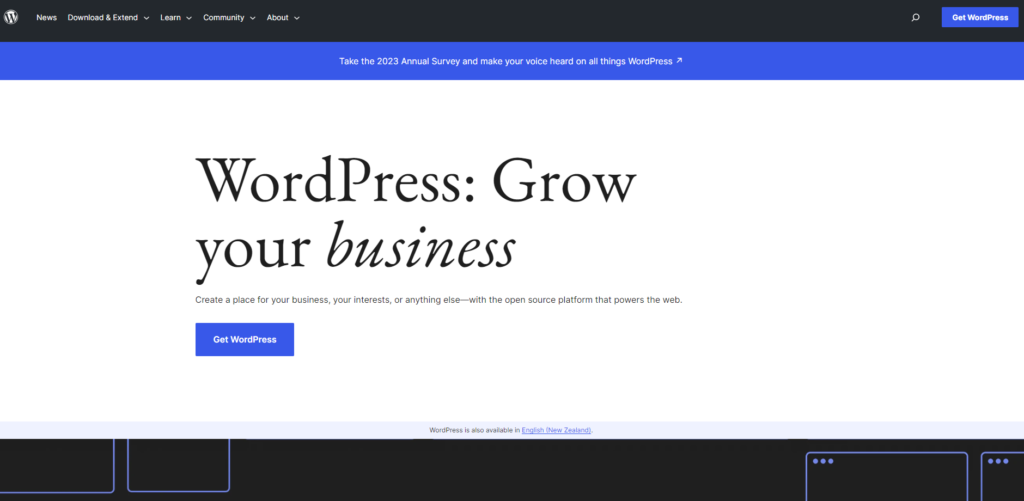
Here’s why it’s a top choice:
WordPress is often the go-to choice for bloggers without question, and for excellent reasons. Many of the most successful and influential bloggers use WordPress as their preferred platform.
The platform offers a blend of power, flexibility, and user-friendliness that makes it suitable for bloggers of all levels, from beginners to seasoned professionals.
Why WordPress?:
- Widespread Usage: WordPress powers a significant portion of websites on the internet. It’s a trusted platform, and its popularity means there’s a vast community of users and developers who can offer support and resources.
- User-Friendly: WordPress offers an intuitive and user-friendly interface. You don’t need to be a tech expert to use it effectively. Whether you’re a teenager just starting out or an experienced blogger, WordPress accommodates all levels of expertise.
- Customization: It provides a high degree of customization. You can select from thousands of themes and plugins to tailor your blog’s appearance and functionality to your preferences.
- SEO-Friendly: WordPress is inherently SEO-friendly, which can help your blog rank well in search engine results, drawing more organic traffic.
- Free and Open Source: The basic WordPress software is free, making it budget-friendly for teenage bloggers. You’ll mainly need to invest in web hosting to set up your website.
3. Sign Up for Web Hosting
Now that you’ve chosen WordPress as your blogging platform, the next critical step is to sign up for web hosting. Here’s what you need to consider when selecting a web hosting provider and why Hostinger is a recommended choice:
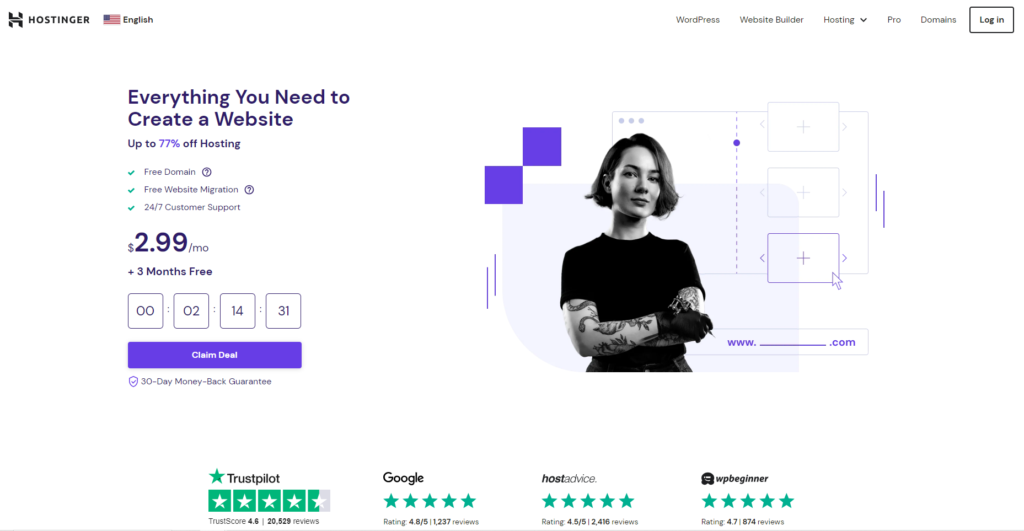
Why Choose Hostinger as Web Hosting
Hostinger is a recommended hosting provider for bloggers, and it’s an excellent choice for several reasons:
- Affordability: Hostinger offers competitive pricing that’s budget-friendly for teenagers looking to start a blog. They provide great value for the cost starting at only $2.99/mo+ 3 Months Free and up to 77% off currently.
- Reliability: Hostinger boasts reliable uptime and fast loading times, ensuring that your blog is accessible to your readers without interruptions.
- Customer Support: Hostinger offers 24/7 customer support with a helpful and responsive team that can assist with any issues or questions you may have.
- User-Friendly Control Panel: They provide an easy-to-use control panel that simplifies website management, making it accessible even to beginners.
- WordPress-Friendly: Hostinger is known for its compatibility with WordPress, with one-click installation for your convenience.
How to get started with Hostinger
Getting started with Hostinger is easy, Just follow these steps:
- Visit the Hostinger website and click on “Sign Up.”
- Choose the desired application, such as WordPress.
- Select a server provider, such as Hostinger’s own hosting infrastructure.
- Choose a suitable hosting plan.
- Decide on the server size, with the recommended option depending on your specific needs.
- Input your billing information and click “Launch.”
- Select a domain name, either by registering a new one or transferring an existing domain.
- Choose your preferred server location.
- Configure your WordPress site.
- Connect your domain name with your Hostinger server.
4. Design Your Blog
With your web hosting in place, it’s time to give your blog an attractive and functional design. Here’s how you can go about it:
Picking a Theme:
Choosing a WordPress theme is a critical design decision, and the Kadence theme is a popular and well-regarded choice for bloggers. Its user-friendly features and versatility make it a great option for a teenage blogger like yourself.
Designing Your Four Core Pages:
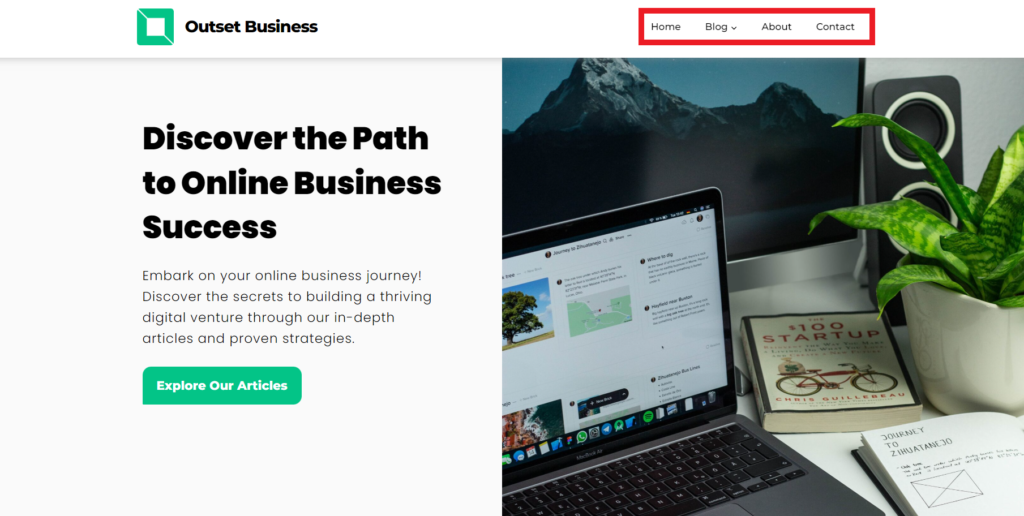
- Home Page: Your home page is the virtual front door to your blog. It should be welcoming and provide an overview of what your blog is about. Use engaging headlines, attractive images, and clear navigation menus.
- Blog Archive: This is where your blog posts are organized and displayed. Make sure it’s user-friendly, with categories or tags to help visitors find the content that interests them.
- About Page: The “About” page is your opportunity to introduce yourself to your readers. Share your story, your passion for your blog’s topic, and why you’re qualified to write about it.
- Contact Page: The contact page is essential for reader engagement. Include a contact form or your email address so that readers can get in touch with you easily.
Design Tips:
- Simplicity: Keep your blog design simple and clean. Avoid clutter and excessive visual distractions. A minimalist approach often works best.
- Color Scheme: Choose a well-mixed color scheme that complements your niche and represents your blog’s personality. Consistency in colors can make your blog more visually appealing.
- Modern Aesthetics: Aim for a modern and up-to-date design. Outdated designs can deter visitors, so consider using contemporary fonts, layouts, and design elements.
- Avoid Perfectionism: While a polished design is important, don’t get lost in perfectionism. Your focus should be on creating valuable content and building your blog. Design enhancements can come later as you grow.
- Keep it Concise: Ensure that each section of your blog is not too lengthy. Readers often prefer easily digestible content.
Remember, while a well-designed blog is essential for a positive user experience, the most crucial aspect is creating valuable content and generating income. Balance your design efforts with the practicality of blogging.
5. Write Your First Search Engine Optimized Blog Post
Creating your first blog post is an exciting step, but it’s crucial to ensure that it’s search engine optimized to reach a wider audience. Here’s how to get started:
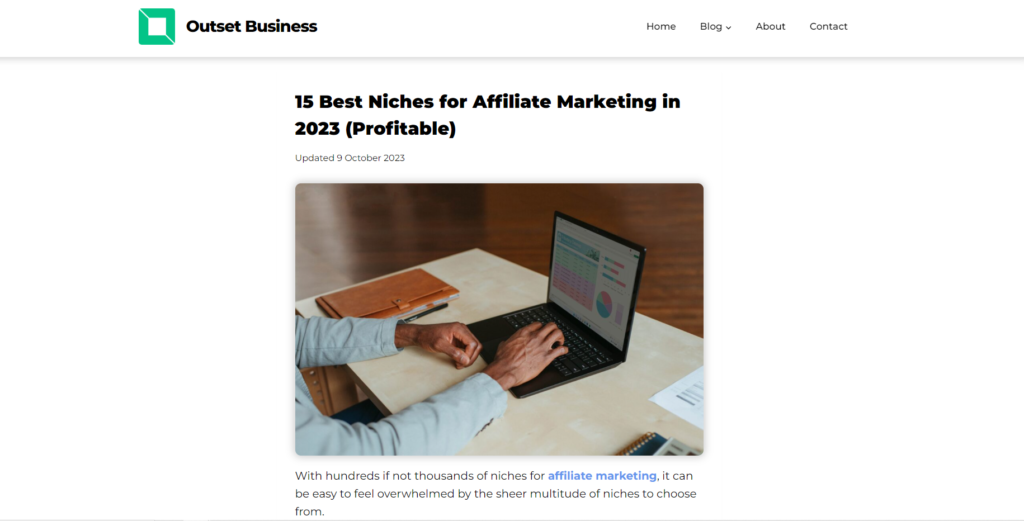
Keyword Research: Before you start writing, conduct keyword research to identify the terms and phrases your target audience is searching for. Tools like Ahrefs and Semrush can help you discover relevant keywords.
Craft an Engaging Title: Your blog post’s title should be both compelling and include your target keyword. It should give readers a clear idea of what the post is about.
Quality Content: Write high-quality, valuable content that addresses the needs and interests of your target audience. Ensure your post provides value and is well-researched.
Keyword Placement: Integrate your target keyword naturally throughout the content, including in headings, subheadings, and the body of the text. However, avoid keyword stuffing, as it can harm your SEO efforts.
Optimize Images: If your blog post includes images, optimize them by adding relevant alt text with your target keyword. This helps with SEO and makes your content more accessible.
Internal and External Links: Include both internal links to other relevant posts on your blog and external links to reputable sources. This not only enhances the user experience but also boosts your SEO.
Meta Description: Craft an engaging meta description that includes your keyword. This description appears in search engine results and can influence click-through rates.
Mobile-Friendly: Ensure your blog post is mobile-friendly, as many users access websites on smartphones and tablets.
Proofread and Edit: Thoroughly proofread and edit your post to eliminate errors and ensure readability.
Writing a search engine optimized blog post is a skill that improves with practice. Over time, you’ll become more adept at creating content that not only resonates with your audience but also ranks well in search engine results, driving organic traffic to your blog.
6. Create a Content Calendar
A content calendar is an invaluable tool for maintaining consistency and organization in your blogging journey. Start by defining your blogging goals, whether it’s increasing traffic, boosting engagement, or setting a specific posting frequency.
Next, identify the main topics or categories that align with your niche and audience interests. Establish a realistic posting schedule, whether it’s once a week, twice a month, or another frequency that suits your goals. Regular keyword research will help you discover trending topics and relevant keywords for your content.
Create an editorial calendar with publication dates for your planned blog posts, ensuring a steady flow of fresh content.
Maintain an ongoing list of potential blog post ideas and strive for a balanced mix of content types to keep your blog diverse and engaging. Be flexible to accommodate unexpected opportunities or events that may warrant immediate attention or changes to your schedule.
Develop a strategy for promoting your content after it’s published, incorporating social media, email newsletters, and audience outreach. Utilize analytics tools to track the performance of your blog posts, allowing data-driven decisions for future content.
A well-structured content calendar empowers you to stay organized, meet your goals, and deliver valuable content to your audience consistently.
7. Promote Your Blog
Promoting your blog is essential to increasing its visibility, reaching a broader audience, and driving traffic to your articles.
Why Promote Your Blog and Articles:
Promotion is vital because it helps you get your content in front of the right audience, expand your readership, and ultimately achieve your blogging goals. Without promotion, your exceptional content may go unnoticed in the vast online landscape.
Here’s how to promote your blog:
Social Media: Leverage the power of social media platforms like Facebook, Twitter, Instagram, and LinkedIn. Share your blog posts, engage with your followers, and use relevant hashtags to reach a broader audience. Consider creating a content calendar specifically for your social media promotion efforts to maintain consistency.
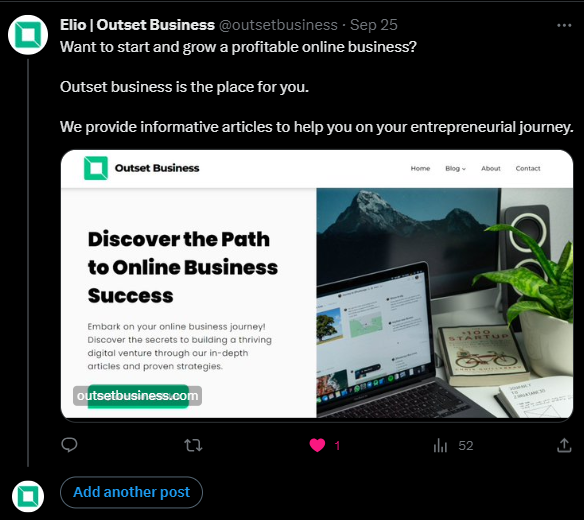
Create a Blog Newsletter: Email marketing, in general, boasts an impressive ROI, with an average return of $42 for every $1 invested. Building an email list and sending out a regular blog newsletter is an effective way to engage your audience. Encourage visitors to subscribe to your newsletter, and send them updates on your latest blog posts, exclusive content, and relevant news. Email marketing can nurture a loyal readership.
Write for Other Sites (Guest Posting): Guest posting on other blogs or websites in your niche is an excellent way to gain exposure. It allows you to tap into existing audiences and establish yourself as an authority in your field. Reach out to other bloggers and websites, offering to contribute valuable content.
Invest in Paid Ads: Paid advertising can be a valuable tool for promoting your blog. Platforms like Google Ads and social media advertising on Facebook and Instagram allow you to target specific audiences. Start with a modest budget, and as you see positive results, consider increasing your investment.
Remember, promotion is an ongoing process, and it may take time to see significant results. Consistency is key, so keep promoting your blog through various channels to reach a wider audience and continue to build your blog’s reputation and readership.
8. Monetize Your Blog
Monetizing your blog can turn your passion into a profitable venture. There are numerous ways to generate income from your blog, and here are some effective strategies:
- Affiliate Marketing: Affiliate marketing is by far the most popular way to monetize your blog. promote products or services relevant to your niche and earn commissions on sales or leads generated through your unique affiliate links.
- Ad Revenue: Display ads on your blog through advertising networks like Google AdSense. You earn money based on ad impressions and clicks.
- Sell an Online Course: Share your expertise by creating and selling online courses related to your blog’s niche. Platforms like Udemy or Teachable can help you get started.
- Build an Email List: Grow your email list and utilize it for email marketing. You can promote products, courses, and affiliate offers directly to your subscribers.
- Offer Online Coaching: Use your blog to establish your expertise and offer one-on-one coaching or consulting services. You can charge clients for your guidance and support.
- Write and Sell an eBook: Compile your knowledge into an eBook and sell it on platforms like Amazon Kindle or through your blog. eBooks can be a lucrative income source.
- Sell Digital Products: Create and sell digital products such as templates, printables, or software tools that cater to your niche.
- Start a Paid Email Subscription: Offer exclusive content or perks to subscribers who pay for a premium email subscription. This can provide a steady stream of income.
- Write Sponsored Posts: Collaborate with brands and businesses in your niche to write sponsored content in exchange for payment or products.
Blogging Fact
According to a survey conducted by VigLink, 65% of bloggers use affiliate marketing as one of their primary monetization methods.
Diversifying your income streams by combining several of these monetization methods can help you maximize your earnings. It’s essential to balance monetization with providing valuable content and maintaining the trust of your audience.
Over time, as your blog and readership grow, your income potential can increase significantly.
9. Analyze Your Results and Keep Growing
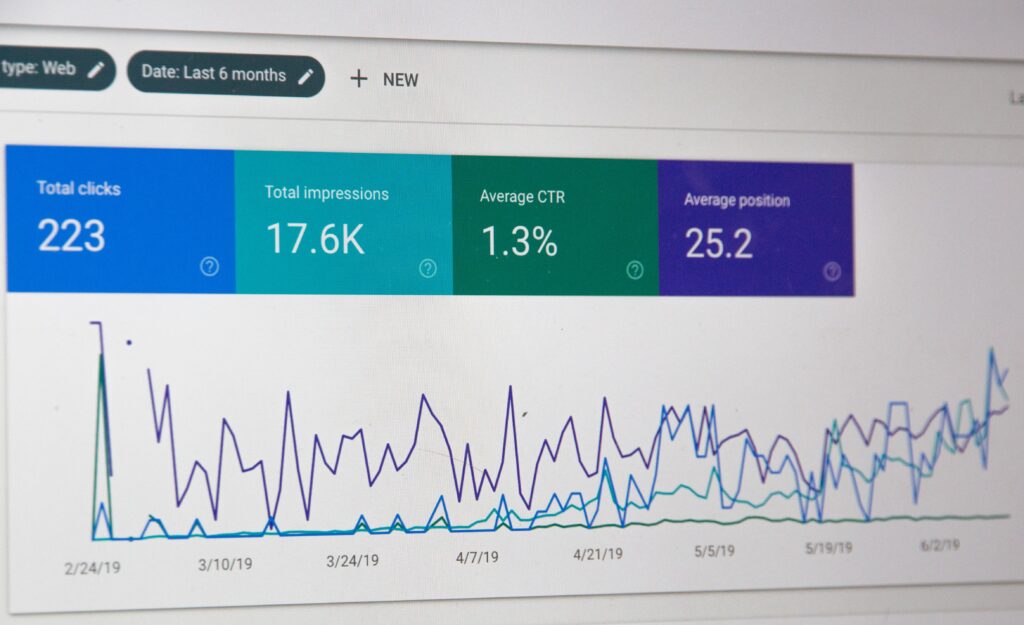
In the ongoing evolution of your blogging journey, the ninth step entails the continuous analysis of your results and the relentless pursuit of growth.
This involves tracking key metrics through website analytics through Google Analytics and Google Search Console, evaluating content performance, and staying attuned to audience feedback. A critical aspect is the examination of your monetization strategies, ensuring they’re effective and align with your goals.
Additionally, competitor research can offer valuable insights, while SEO and keyword analysis help maintain your blog’s visibility. Set fresh objectives based on your findings, commit to continual learning, adhere to a consistent content creation schedule, and nurture your network.
By adapting to changing dynamics and consistently improving, your blog will not only thrive but also stand the test of time.
Blogging Tips for Teenagers
Embarking on a journey as a teenage blogger is an exciting venture filled with opportunities for growth and learning. To make the most of this experience, here are some essential tips to help you navigate the blogging world effectively and make your blog a success.
1. Implement Link-Building
Link-building is a fundamental strategy in the world of blogging. Embrace it as an essential SEO (Search Engine Optimization) tactic to enhance your blog’s reach and authority. Internal links are like the connective tissue of your blog, creating a web of interconnected content that not only improves user experience but also keeps visitors engaged and exploring your site for longer.
On the other hand, external links to reputable sources demonstrate your commitment to delivering trustworthy information. They add credibility to your blog and make it a more valuable resource for your audience. I recommend using guest posting as your main link-building strategy. Guest posting is one of the most popular link-building methods to build authority in the blogging game.
2. Think Long-Term
Blogging is a marathon, not a sprint. To succeed in the long run, it’s crucial to adopt a long-term perspective. Building a successful blog takes time, consistent effort, and dedication. Patience and persistence are your most valuable allies.
While immediate results are gratifying, it’s the cumulative effort and quality content over time that will lead to the achievement of your goals. Understand that your blog’s growth is an ongoing process that requires ongoing commitment.
3. Network
In the digital world, networking is an invaluable asset for bloggers, especially for teenagers looking to make their mark. Engage with fellow bloggers, both within and outside your niche. Establishing connections with other bloggers can open doors to exciting opportunities.
Collaborations, guest posting, and cross-promotion can significantly expand your blog’s reach. Sharing ideas, experiences, and expertise with your blogging peers not only enriches your knowledge but also creates valuable connections that can support your growth and journey.
4. Create SEO Content
Search Engine Optimization (SEO) is a critical element in making your blog discoverable by a broader audience. To boost your blog’s visibility, conduct keyword research to identify the terms and phrases your target audience is searching for.
Use these keywords naturally within your content, optimizing your articles for search engines. Additionally, structure your content with SEO in mind, incorporating headers, meta descriptions, alt tags, and other SEO best practices. A well-optimized blog can rank higher in search engine results, attracting more organic traffic.
5. Learn and Improve
The blogging landscape is ever-evolving, and to thrive as a blogger, you should never stop learning. Stay updated with the latest industry trends, blogging techniques, and technological advancements. Continual self-improvement is the path to refining your blogging skills and achieving success.
Seek out educational resources, attend webinars, read industry blogs, and invest in your education to keep growing as a blogger. An insatiable appetite for learning will not only make you a better blogger but will also keep your content fresh and engaging for your audience.
Best Tools for Blogging
1. Semrush
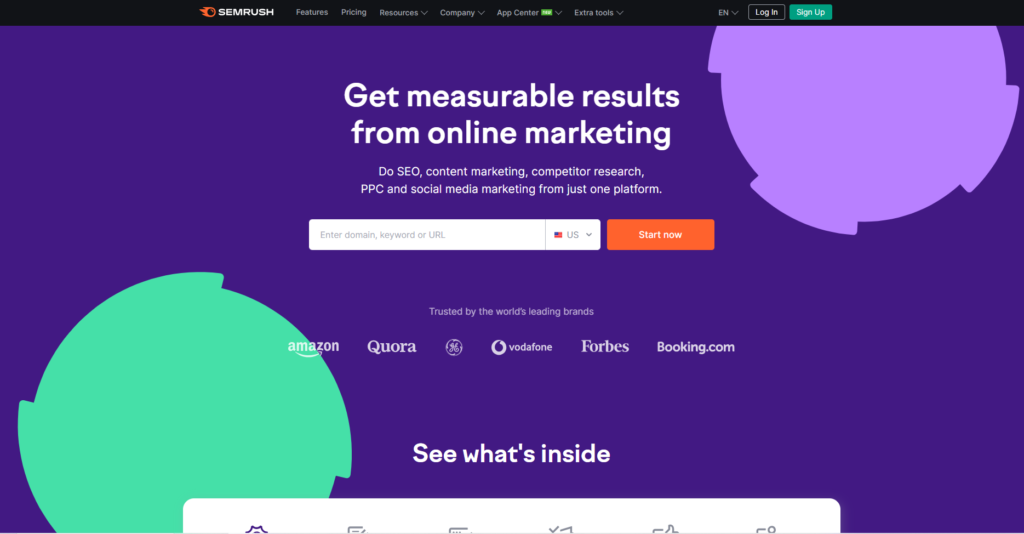
Semrush stands as an indispensable all-in-one digital marketing toolkit for bloggers. This versatile platform offers a plethora of features designed to optimize your blog’s overall performance and visibility in the digital realm.
Semrush’s arsenal includes tools for in-depth keyword research, site auditing, competitor analysis, and more.
These features provide bloggers with valuable insights into their niche, enabling them to refine their SEO strategies and content marketing efforts. The tool’s comprehensive nature allows you to address various facets of your blog’s success in one place.
Semrush offers several pricing plans, starting at $99.95 per month. It also offers a free trial, allowing you to explore its capabilities before committing to a subscription. However they also offer a 100% free plan with limited features.
2. Google Analytics
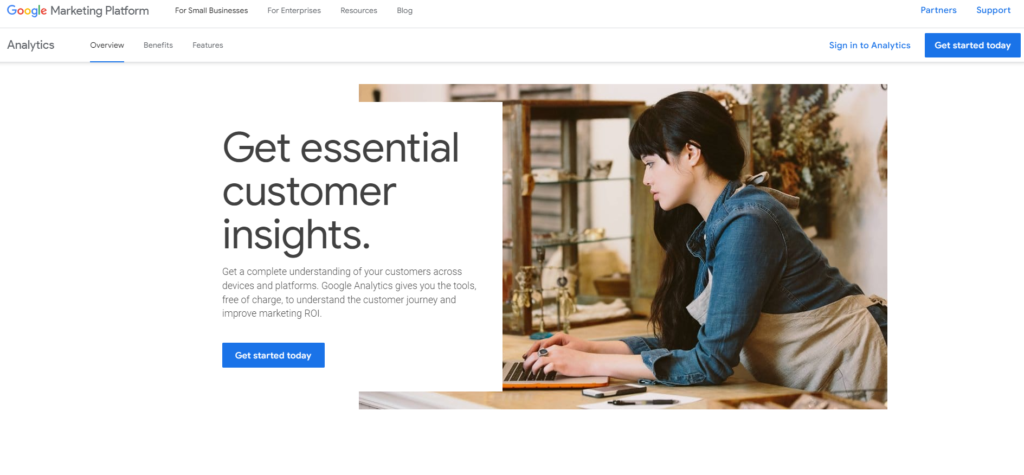
Google Analytics is a trusted web analytics service offered by Google. It’s a must-have when if you’re looking to run a blog. It plays a pivotal role in your blogging journey by providing you with critical insights into your blog’s traffic and user behavior.
This service tracks website traffic, offering data on visitor demographics, page views, bounce rates, and more. Understanding how users engage with your blog is essential for optimizing your content and tailoring it to your audience’s preferences.
The best part is, Google Analytics is entirely free to use, making it accessible to bloggers of all levels without any financial burden.
3. Surfer SEO
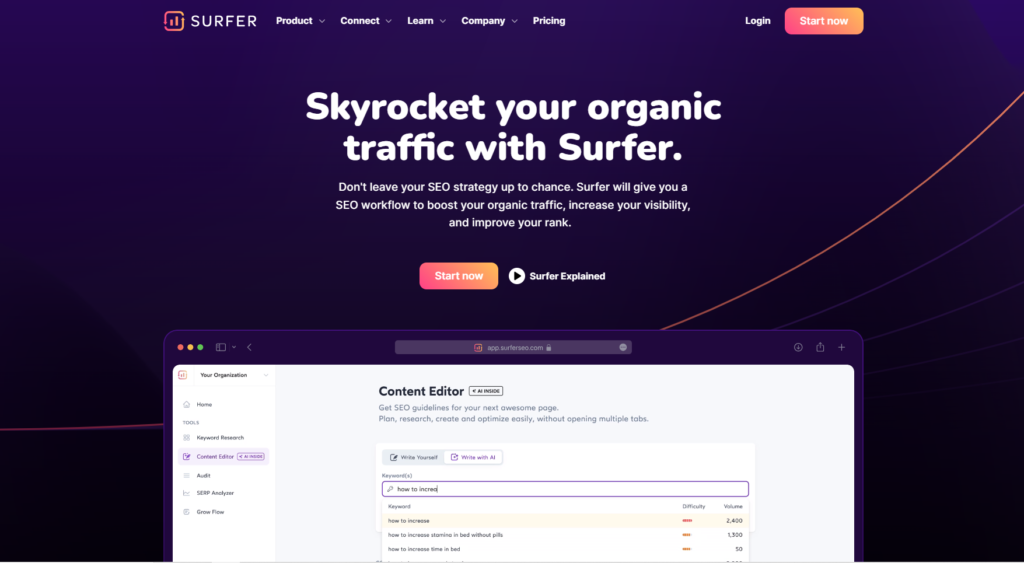
Surfer SEO is a valuable on-page optimization tool that simplifies the process of analyzing your blog’s top-ranking competitors and improving your content.
It works by writing SEO content by taking advantage of AI.
The platform offers a range of features, including recommendations for optimizing your content based on the performance of competitors’ pages. This helps ensure your blog posts are SEO-friendly and competitive in your niche, making it a powerful ally in your blogging journey.
Surfer SEO’s pricing starts at $59 per month, making it an affordable choice for bloggers seeking to enhance their on-page SEO.
4. Ahrefs
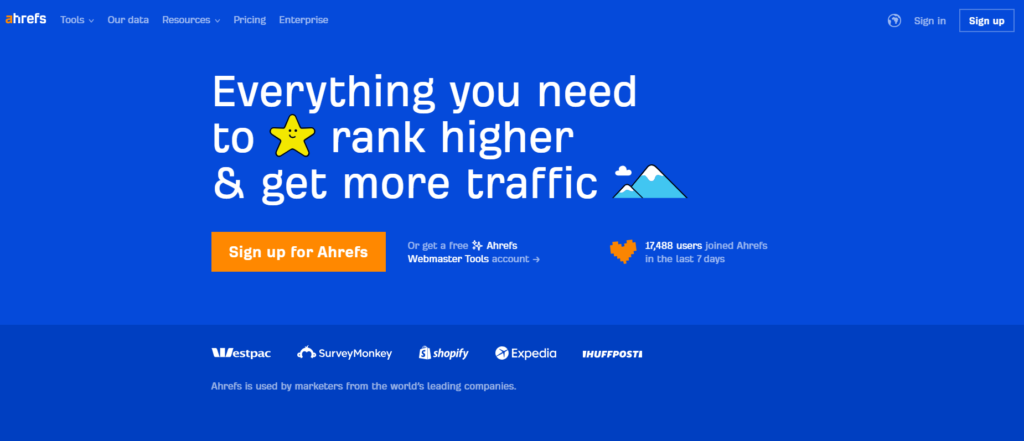
Ahrefs is a renowned SEO toolset known for its comprehensive backlink and keyword research capabilities. It’s a must-have for bloggers looking to boost their SEO efforts.
Ahrefs provides tools like site explorer, keyword explorer, and content explorer to help you gain deeper insights into your blog’s performance and how it compares to competitors. This data is invaluable for refining your content strategy and improving your blog’s visibility.
Ahrefs offers several pricing plans, starting at $99 per month. It also provides a 7-day trial for just $7, allowing you to test its features and see how they can benefit your blog.
5. Google Trends
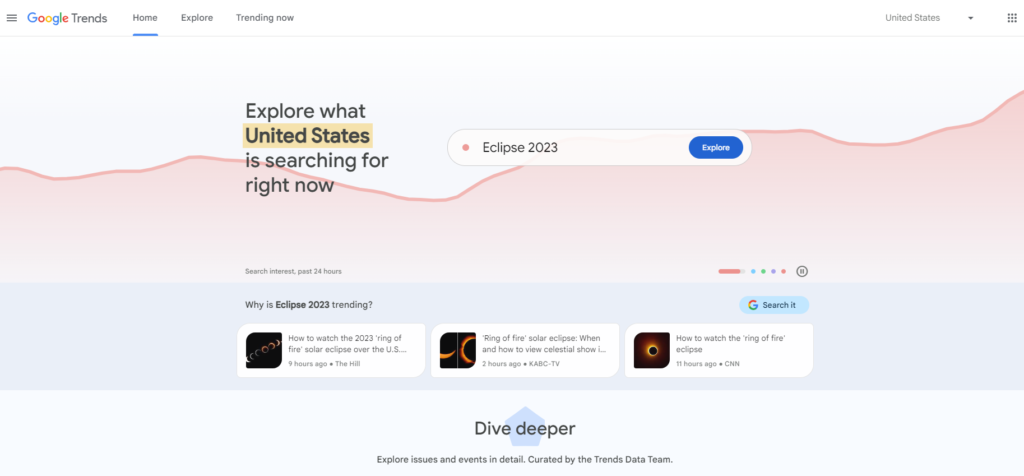
Google Trends is another valuable, free tool provided by Google that assists bloggers in understanding the popularity of specific search terms and topics over time.
It’s particularly helpful in identifying trending topics and keywords that are currently of interest to online users. By using Google Trends, you can ensure that your blog content remains relevant and aligned with the current interests and search trends of your target audience.
Google Trends is entirely free to use, making it an accessible resource for bloggers looking to stay current and capitalize on the latest trends.
If you would like to see more tools like these check my article on the best AI writing tools.
FAQ
Here are some of the most asked questions when it comes to starting a blog as a teenager
What is a Blog?
A blog is a regularly updated online platform where individuals or organizations share their thoughts, expertise, and information on various topics. It often takes the form of a website that displays posts in reverse chronological order, with the most recent content at the top.
Can a Teenager Make Money From Blogging?
Absolutely, teenagers can make money from blogging. Many young bloggers have found success by creating valuable content, growing their audience, and monetizing their blogs through methods like affiliate marketing, ad revenue, and selling digital products.
How Do I Start a Blog
To start a blog, you’ll need to choose a niche, pick a blogging platform, secure web hosting, design your blog, create and optimize content, promote it, and explore monetization options. There are numerous online resources and guides to help you through each step.
Is Blogging Dead?
No, blogging is not dead. Blogs continue to thrive as a valuable medium for sharing information, expertise, and building online communities. They remain a crucial part of the digital landscape.
What is the Difference Between a Blog and a Website?
The main difference between a blog and a website lies in their structure and content. A blog is a type of website that primarily focuses on presenting content in the form of regularly updated blog posts. Websites, on the other hand, encompass a broader range of content and may include static pages, e-commerce functionality, forums, and more. Essentially, all blogs are websites, but not all websites are blogs.
Conclusion
That’s it for how to start a blog as a teenager in 2024, thanks for making it to the end.
In the digital age, teenage blogging in 2024 offers an array of opportunities. Beyond just the potential for profits, it’s a pathway to self-discovery, skill development, and the chance to share your unique perspective with the world.
By diligently following the steps, utilizing the tools, and embracing the wisdom shared in this guide, you can not only launch a profitable blog but also embark on a journey that enriches your life in numerous ways.
So, don’t hesitate to start your blogging adventure today, and watch as your ideas and dedication blossom into a thriving online presence.
But remember, you’ll never achieve blogging success without the right mindset, you need to stay persistent, disciplined, and consistent.
If you’d like to see more like this, check out my article on the best profitable blogging tips for beginners.
Thanks again for making it to the end of this blog post and as a fellow blogger, I wish you luck with your teenage blogging journey!
So, are you going to make that leap of faith and start a blog?




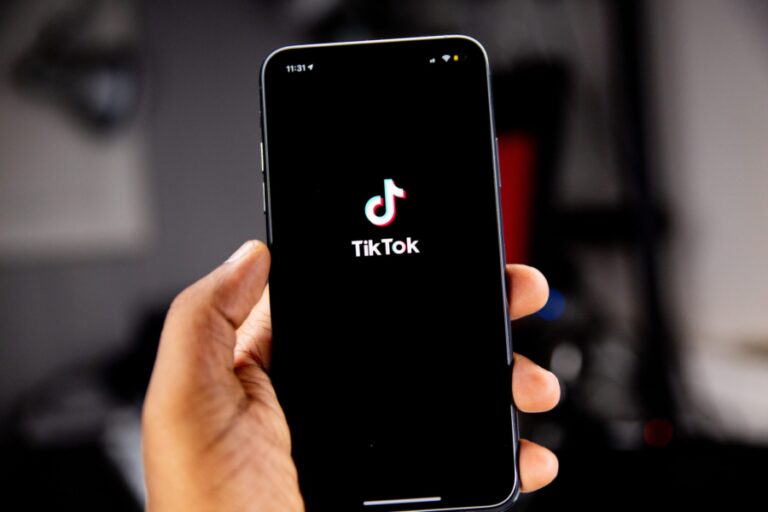


Excellent post, I recommend Surfer SEO.